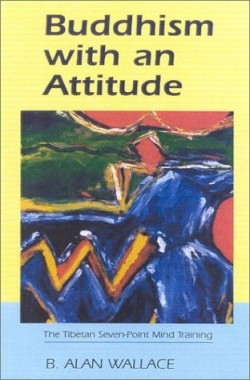Buddhism with an Attitude
The Tibetan Seven-Point Mind Training
When Alice fell down the rabbit hole and entered Wonderland, she exclaimed “Curiouser and curiouser.” Perhaps she maintained her equilibrium amongst all the oddity by considering the dreamlike nature of her experience. According to Buddhism, the life people lead is Maya, illusion, and suffering can be transcended by accepting the illusion of reality and practicing “the four thoughts that turn the mind.” In Buddhism with an Attitude, Wallace outlines the seven Tibetan precepts of mind training by which one can attain “the natural, genuine happiness within.”
The seven points Wallace addresses move from the most abstract premises of Buddhism to the practical applications of mind training. He begins with a discussion of the nature of reality according to Buddhism and the way one’s unawakened consciousness keeps one bound to suffering and attachment. Only by considering the transience of all things can we begin to practice mindfulness, for “When we overlook our own impermanence, there is a natural tendency to grasp onto the good things that come along. This is called attachment, and once we are set in this pattern of holding on, only one of two things can happen—either the object will disappear or we will disappear.” Once one understands the nature of reality, one can silence the “mind frothing at the mouth” and begin the practice necessary to achieve mental quiescence that leads to “an experience of bliss throughout the body and mind, and extraordinary lightness, as well as a dexterity of mind.”
Even for one who does not practice Buddhism, Buddhism with an Attitude is an erudite essay on spirituality, psychology, and quantum physics, and challenges one to think about personal growth. Wallace not only quotes great Buddhist teachers such as Padmasmbhava and Gyatrul Rinpoche, but moves dexterously from William James, to John Muir, Henry David Thoreau, and Niels Bohr. Perhaps the most intriguing concept Wallace presents is the conjunction of Buddhist theology with quantum mechanics. This coincidence of science and religion, the West and the East, makes abstract Buddhist theology more relevant to Western minds. The book incorporates meditation guidance as well as theory and reminds the reader “the undisciplined mind, prone to laxity, excitation and distraction, is dysfunctional.”
Reviewed by
Duncan Sprattmoran
Disclosure: This article is not an endorsement, but a review. The publisher of this book provided free copies of the book to have their book reviewed by a professional reviewer. No fee was paid by the publisher for this review. Foreword Reviews only recommends books that we love. Foreword Magazine, Inc. is disclosing this in accordance with the Federal Trade Commission’s 16 CFR, Part 255.

